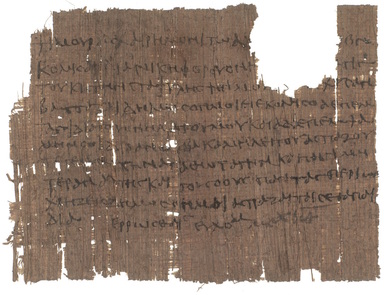 P.Col. 10.253
P.Col. 10.253 In P.Col. 10.253 (2nd century CE), we meet Nikephoros, a donkey-driver (ὀνηλάτης) who is described as being "branded" (σφραγίζειν). Psimouras is writing a letter to his brother Chairemon informing him that he is sending him a basket of grapes through Nikephoros. The second editors (Roger Bagnall and Dirk Obbink) remark that, although the word "branded" must be partially reconstructed, nothing else fits the space and context.
If Nikephoros is branded, it probably means that he was a slave. Owners of slaves commonly tattooed their slaves for identification, and runaway slaves were often tattooed or branded on the face until Constantine forbade it in 315/6. Here, Psimouras mentions Nikephoros' branding so that Chairemon will know how to recognize him. This is similar to the various ways in which people are identified in the papyri by their scars. For example, in the abstracts of contracts found at Tebtunis, we find many references to the placement of scars and other bodily markers, such as, "about 28 years old with a scar on the right shin" or "about 55 years old having as a mark a mole by the left ear," or "about 42 years old with a scar on the middle of his nose" (all from P.Mich. 2.121).
In any case, the use of the term σφραγίζειν to describe a slave is rare in the papyri, which makes this papyrus all the more interesting. Anoubas the camel-driver mentioned further down in the letter is not further described, but perhaps he was also described as being "branded" in a previous letter sent to Chairemon, now lost. For general reading, see C.P Jones, "Stigma: Tattooing and Branding in Graeco-Roman Antiquity," JRS 77 (1987): 139-55.
If Nikephoros is branded, it probably means that he was a slave. Owners of slaves commonly tattooed their slaves for identification, and runaway slaves were often tattooed or branded on the face until Constantine forbade it in 315/6. Here, Psimouras mentions Nikephoros' branding so that Chairemon will know how to recognize him. This is similar to the various ways in which people are identified in the papyri by their scars. For example, in the abstracts of contracts found at Tebtunis, we find many references to the placement of scars and other bodily markers, such as, "about 28 years old with a scar on the right shin" or "about 55 years old having as a mark a mole by the left ear," or "about 42 years old with a scar on the middle of his nose" (all from P.Mich. 2.121).
In any case, the use of the term σφραγίζειν to describe a slave is rare in the papyri, which makes this papyrus all the more interesting. Anoubas the camel-driver mentioned further down in the letter is not further described, but perhaps he was also described as being "branded" in a previous letter sent to Chairemon, now lost. For general reading, see C.P Jones, "Stigma: Tattooing and Branding in Graeco-Roman Antiquity," JRS 77 (1987): 139-55.
| Ψιμουρᾶς Χαιρήμονι τῷ ἀδ[ελφῷ χαί]ρειν. κόμισαι διὰ Νικηφόρου ὀνη[λάτου σφρ]αγισ- τοῦ κίστην σταφυλῆς ἥν μοι εἰ[ς τὴ]ν χρέαν βαστάξαι. δήλωσόν μοι εἰ ἐκομισο ἃ ἔπεμ- ψά σοι διὰ τοῦ ὀνηλάτου μου καὶ ἃ διεπεμψά- μην σοι διὰ Ἀνουβᾶ καμηλείτου. ἀσπάζου Τετε ̣ ̣ν τὴν ἀγαθωτάτην καὶ τὴν μη- τέραν αὐτῆς καὶ τοὺς σοὺς πάντας. περὶ ὧν χρῄζεις δήλωσόν μοι. ἀσπάζαιταί σε τὰ παι- δία. ἔρρῶσθαί \σ<ε>/ εὔχομ(αι) Μεχ(εὶρ) κθ. -- -- -- -- -- -- -- -- -- -- | "Psimouras to Chairemon his brother, greetings. Receive through Nikephoros the branded (?) donkey-driver a basket of grapes which was the only one they were able to carry. Let me know if you received what I sent you through my donkey-driver and what I had sent to you through Anoubas the camel-driver. Greet the excellent Tete(. .)s and her mother and all your people. Let me know what you need. The children greet you. I pray for your health. Mecheir 29." |
